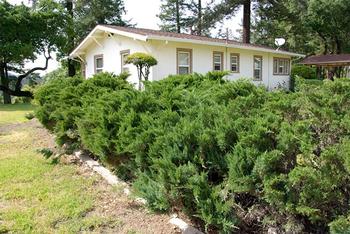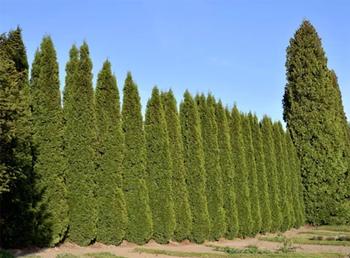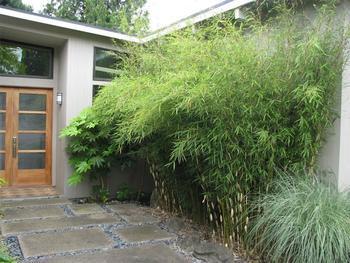Create a fire-smart landscape with proper design, regular maintenance, and careful plant selection
-
Julie McMillan
-
There is no such thing as a “fire-proof” plant; all plants can burn, especially when they are dead, poorly maintained, or drought stressed. To create a fire-smart landscape, proper design, and regular maintenance are critical. Carefully selecting plants with certain characteristics, and avoiding others, also matters.
 Don’t plant in Zone 0, 5' & avoid juniper and other plants that contain resin, volatile oils, or sap that release energy when burning. Fire Safe Marin
Don’t plant in Zone 0, 5' & avoid juniper and other plants that contain resin, volatile oils, or sap that release energy when burning. Fire Safe MarinAccording to Steven Swain, UC Cooperative Extension Environmental Horticulture Advisor for Marin and Sonoma Counties, “Design and maintenance are more important than plant selection.”
When designing your garden, determine the best location for your plants following the three defensible space zones:
Zone 0: 0-5’ from your house and the most important. Eliminate all combustible materials, including in-ground plants and organic mulch. Use only non-combustible materials (concrete, brick, rocks, decomposed granite, gravel).
Zone 1: 5-30’ from your house. Create plant islands by separating garden beds with hardscape; provide ample plant spacing to slow the spread of flames and make maintenance easier.
Zone 2: 30-100’ from your house. Use larger shrubs planted in widely spaced groups or islands.
Space trees apart so that at maturity, their canopies are separated by 10’-15’. Consider how large plants will be at maturity to maintain adequate spaces, with more space between plants on slopes.
Follow these four steps to ensure you are properly maintaining your garden: Avoid Italian cypress and other plants that accumulate dead materials where they are difficult to remove. Fire Safe Marin
Avoid Italian cypress and other plants that accumulate dead materials where they are difficult to remove. Fire Safe Marin- Clean up: Regularly remove dead or dry plants, grass, weeds, trees, and branches; remove dead or dry leaves and needles from your yard, roof, and gutters; remove and replace struggling plants.
- Water: keep your plants well hydrated; check your irrigation system regularly.
- Use appropriate mulch: In Zone 0, use only inorganic mulch (rocks, decomposed granite, gravel). In the other zones, composted wood chips are best; avoid highly flammable mulches (such as shredded western red cedar, or “gorilla hair,” shredded rubber, and pine needles).
- Prune: Cut back woody, twiggy, or overgrown shrubs; thin and reduce tree canopies; limb up trees 6-10’ from the ground or up to one-third their height.
While not as critical as design and maintenance, plant selection is also important. Swain recommends “California native or other pollinator-friendly plants that require little water and are easy to maintain.” Succulents are also good options. Choose plants and trees that meet your garden’s cultural conditions: Consider the amount of sun in your garden; type of soil; microclimate; and setting, including slope. Include plants with the following characteristics:
- little seasonal accumulation of dead vegetation to make maintenance easier
- trees that lose their leaves in the fall (deciduous) because they have higher moisture content when in leaf
- open branching to reduce the likelihood of catching embers
- slow growing to require less pruning
- non-resinous material (stems, leaves, or needles that are not resinous, oily or waxy)
- high moisture content in their leaves (such as succulents or vegetables)
Avoid plants with these characteristics: Avoid plants such as bamboo that are difficult to maintain due to their accumulation of dead material. Fire Safe Marin
Avoid plants such as bamboo that are difficult to maintain due to their accumulation of dead material. Fire Safe Marin- difficult to maintain due to accumulation of dead woody material, dead leaves, or other hazardous dead growth (eucalyptus, palms, bamboo, and some manzanitas that shed dry bark)
- a physical structure making routine maintenance more difficult because of accumulation of dead material (juniper, Italian cypress, feather, fountain, and Pampas grasses)
- a high surface area to volume ratio, containing fine needles or lacy leaves (Monterey pines)
- containing resin, volatile oils, or sap with a strong odor that release more energy when they burn (lavender, rosemary, juniper, acacia, pine, spruces, and firs)
Several Marin jurisdictions prohibit certain plants. The City of San Rafael requires the removal of juniper, bamboo, black acacia, and Italian cypress. While it acknowledges that no plant is “fireproof,” the City also recognizes that removing some of the most pervasive and fire-prone plants reduces wildfire risk and its spread.
Proper design, regular maintenance, and careful plant selections will help you create a fire-smart landscape.
More information about how to select plants can be found on the UC Marin Master Gardener website: https://marinmg.ucanr.edu/PLANTS/HOW_TO_CHOOSE/; and for general fire-smart landscaping information, please visit the UC Marin Master Gardener website: www.ucanr.edu/ucmarinmgfiresmart.



